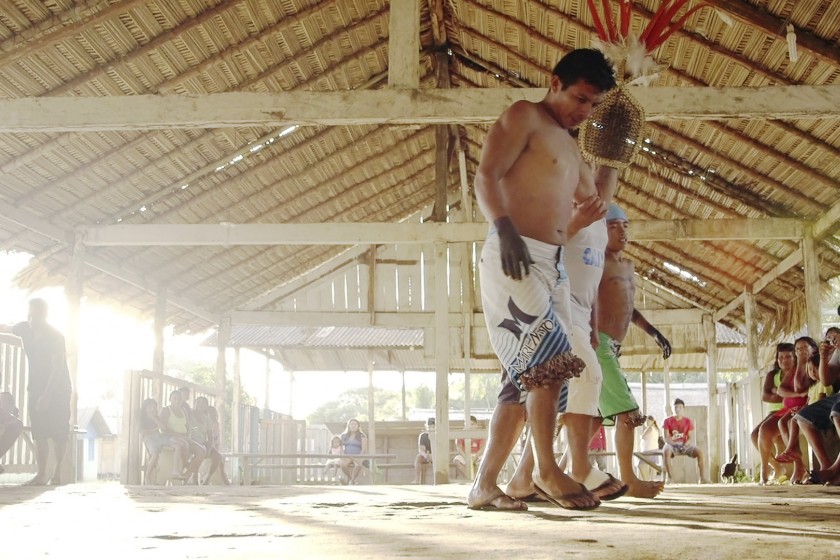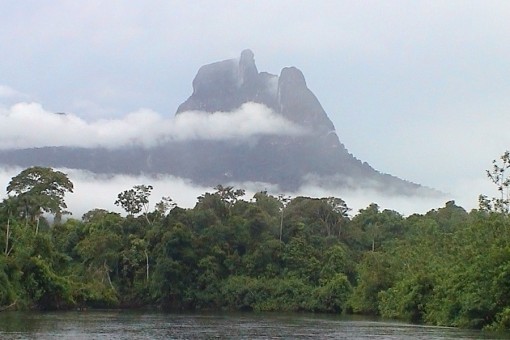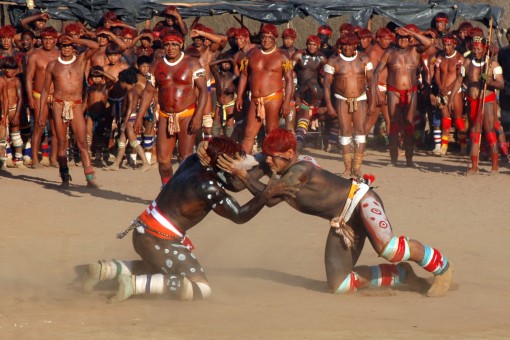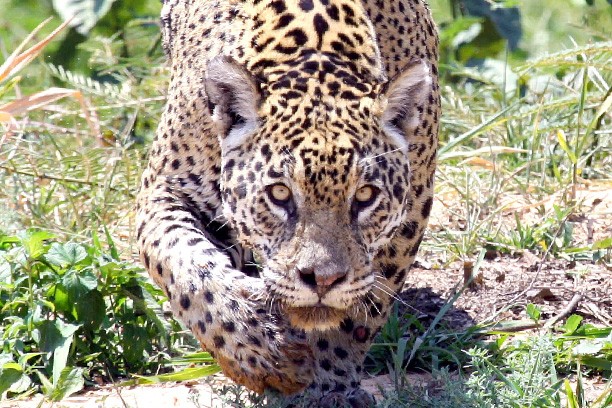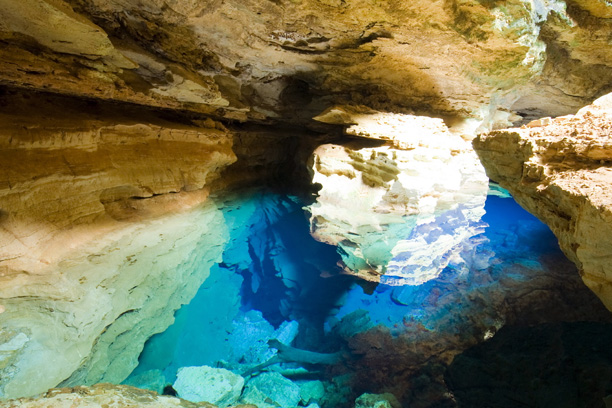overview & history
The Sateré-Mawé Tribe
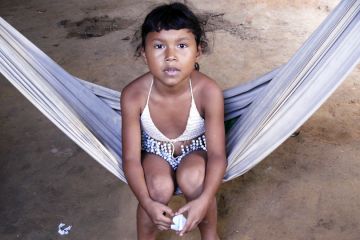
They call themselves Sateré-Mawé. The first word, Sateré, means “burning caterpillar”, a reference to their society’s most important clan, which traditionally appoints the the group’s political chief’s successor. The second word, Mawé, means “intelligent and curious parrot” and is not a clan designation.
The Sateré-Mawé are simply called Mawé in the region. They have been called several names, given by chroniclers, pioneers, missionaries and naturalists: Mavoz, Malrié, Mangnés, Mangnês, Jaquezes, Magnazes, Mahués, Magnés, Mauris, Mawés, Maragná, Mahué, Magneses, Orapium.
Sateré-Mawé live in the region of the mid Amazon river, on the border of the States of Amazonas and Pará. With a total area of 788,528 hectares, their territory is located in the municipalities of Maués, Barreirinha, Parintins, Itaituba e Aveiro, situated in both States.
According to a Funai estimate (Fundação Nacional do Índio – National Foundation for the Indian, the official organ for Indian policy in Brazil), the Sateré-Mawé were 4,710 in 1987. Since then, a considerable growth in population has occured, where in 2014 the estimated total population was 13,350 Sateré-Mawé inhabiting 73 villages.
History
According to oral traditions shared by tribe elders, Sateré-Mawé ancestors lived in the vast area located between the Madeira and Tapajós rivers, the Tupinambaranas Islands on the Amazon river in the north and the Tapajós headwaters in the south.
The Sateré-Mawé refer to their place of origin, where their mythical heroes live, by the name of Noçoquém. It is located on the left bank of the Tapajós, in a rocky region of dense forest, “where the rocks speak”.
The Sateré-Mawé had their first contact with white men when Jesuits founded the Tupinambaranas Mission, in 1669. According to Bettendorf, in 1698 the Andirá received Father João Valladão as missionary. In 1692, after they killed a few white men, the colonial government declared “just war” (legal, justified) against them, which was partially avoided by the Indians because, informed in advance, most of them ran away, so that only a few offered resistance.
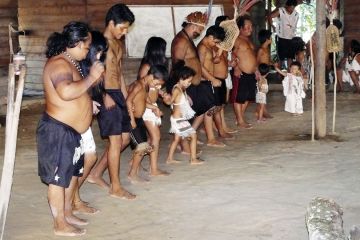
From the time of contact with white men – and even before that, due to the wars against the Munduruku and Parintintim – the Sateré-Mawé’s ancestral territory has been considerably reduced. When Amazonia’s most important insurrection against the cabanagem (the central government after the independence of Brazil) erupted in 1835, the Munduruku, the Mawé (from the Tapajós and Madeira rivers) and the Mura (from the Madeira river), along with the indigenous groups of the Negro River joined the Cabanos rebels, and surrendered only in 1839. Epidemics and atrocious persecution against the indigenous groups that sided with the insurgents devastated huge areas of the Amazon Region, either forcing these Indians out of their traditional territories or reducing their numbers.
Travellers’ reports confirm that there has indeed been a territorial reduction as of the 18th century, and mention the area between the rivers Marmelos, Sucunduri, Abacaxis, Parauari, Amana and Mariacuã as the Sateré-Mawé’s traditional territory. These reports confirm also that the cities of Maués and Parintins, in the State of Amazonas, and Itaituba, in Pará, were built atop Sateré-Mawé sites, which coincide with passages of this people’s oral history.
Thinking in terms of macro-territory, the occupation of the Amazon region by the “civilizados” (civilized) –the word the Sateré-Mawé use to designate all those who are neither Sateré-Mawé nor do they belong to another Indian group (i.e. caboclos, or mestiços, white men, foreigners) – has significantly reduced their traditional territory. First it was military as well as the Jesuit and Carmelite missions; later came the economic cycle of forest products; next, rubber extraction; and finally the expansion of the cities of Maués, Barreirinha, Parintins and Itaituba into their hinterland, with the establishment of farms, the extraction of pau-rosa (rosewood) and the opening of mineral prospecting fields, as well as the control of the Indian’s economy through the regatões (merchants that ply the rivers of the Amazon Region).
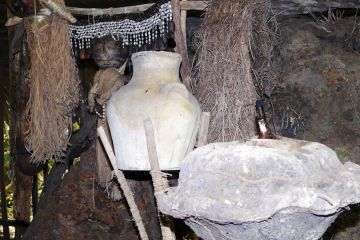
In 1978, when the demarcation process of the Sateré-Mawé territory began, the villages, sites, roças, cemeteries and the territories used for hunting, fishing, gathering and roaming were located between and in the vicinity of the Marau, Miriti, Urupadi, Manjuru and Andirá rivers. The Sateré-Mawé considered that area theirs, although they were aware that it was no more than a small portion of what had been their traditional territory. For them, a privileged part of their territory had been kept.
It should also be pointed out that as of the 1970s, the migratory movement towards Manaus increased. In 1981, the anthropologist Jorge Osvaldo Romano counted 88 Sateré-Mawé living in poor neighborhoods of the city’s outskirts. By the end of the 1990s, the number had grown significantly, and some 500 Sateré-Mawé lived in different housing projects in Manaus’ western edge. This urban population lives, in most cases, from the sale of arts and crafts to tourists.
continue to language & traditions
language & traditions
Language of the Sateré-Mawé
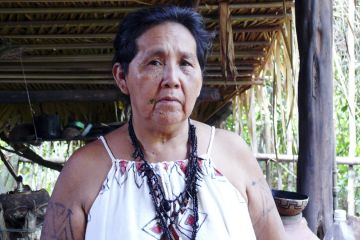
The language spoken by the Sateré-Mawé is part of the Tupi linguistic branch. According to ethnographer Curt Nimuendaju (1948), it differs from the Guarani-Tupinambá. Pronouns are the same as those of the Curuaya-Munduruku language, and the grammar is, it seems, Tupi. The Mawé vocabulary contains elements that are entirely different from Tupi, and cannot be related to any other linguistic family. Since the 18th century, their repertoire includes many words from the língua geral (the language spoken in colonial Brazil until the late 18th Century, a mixture of Indians languages and Portuguese).
Today most Sateré-Mawé men are bilingual – they speak their own language and Portuguese; women, on the other hand, tend to speak only Sateré-Mawé, despite the people’s three centuries of exposure to the national society.
Life in a Sateré-Mawé’s Tribe
The areas in which the Sateré-Mawé live are called sítios. In this space each family unit has its residence, where the unifying central piece is a fire pit used both for cooking and for keeping the residents warm. A separate kitchen is located halfway between the house and the river, where the men roast guaraná and the women prepare manioc. They also have their porto (port) or iagarapé (small waterway), as they call the site where the family members bathe, wash clothes, soak cassava, wash guaraná and land their canoes.
Sítios also contain all the family unit’s fields: the guaraná fields and the roças (planting fields) of cassava, pumpkin, yam, sweet potatoes, as well as the orchards. Sítios are private domains in which the land and other natural resources are taken by family units, who then submit themselves to the authority of the chief of the family group, traditionally regarded as its owner.
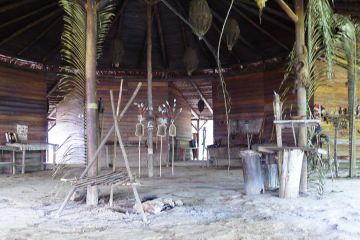
The Sateré-Mawé are organized under the authority of the chief of the extensive family, who lives in his sítio together with his children’s and grandchildren’s families. He directs and organises his sons’ and sons-in-law’s economic activities and the sitio’s agricultural production. As well, he determs who to request for help, when needed. This can include hunting and fishing expeditions well as the roasting of manioc in order to provide food for the participants in the collective activities. During the work, the chief keeps a close eye on all operations, from the clearing of the cassava and guaraná roças, the weeding of the guaraná fields, to the processing of guaraná. He also assists in the sale of his relatives’ agricultural and manufacturing production.
Thus the sítio is the latu sensu, the basic unit of the Sateré-Mawé political and economic organization. It may become a village when the number of family units increases or when, independently from this, one of its members starts to be regarded as a tuxaua (chief). This may occur if he is recognized for his generosity, or his abilities in commercial transactions, or his good relations to other tuxauas.
Currently, the layout of most Sateré-Mawé villages is similar to that of the small towns in the region. Within the villages are the sitios, the churches of various denominations, the school and the infirmary. Surrounding the villages are the cassava roças, the guaraná fields, the orchards and the other planted areas that belong to each family unit.
Culture and Traditions
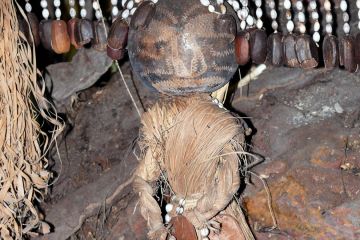
The main expression of the Sateré-Mawé’s rich material culture is the teçume, which is how they call the crafts manufactured by the men with stalks and leaves of caranã, arumã and other Amazon plants, such as sieves, baskets, tipitis (a kind of cylinder used for squeezing the poison out of wild cassava), fans, bags, hats, walls, roofs etc.
Crucial and central to Sateré-Mawé cosmology is the Porantim, a wooden staff measuring approximately 1.50 meters, carved with geometric figures painted in white. In shape it is closest to a carved oar and its attributes are both spiritual and social; an indigenous equivalent to the US Constitution and the Holy Bible, it is considered to have magical powers such as forseeing into the future. It is also used when resolving internal disputes and has engraved upon it both the origin myth and the war myth, the beginnings of Sateré-Mawé history. As such, the Porantim, in all its wooden glory is considered to be the highest institution, representing the political, judicial, religious and mythical spheres of tribe culture.
As per the Sateré-Mawé origin myth, they consider themselves to be the inventors of guaraná culture. Native to the highlands of the Maués-Açu river basin, the plant is located precisely within Sateré-Mawé traditional territory, justifying this historical belief of the tribe being the “Children of Guaraná”. The Sateré-Mawé have transformed the Paullinia cupana, a wild vine of the Sapindacea family, into a cultivated shrub, and mastered its planting and processing.
A spectacular, frightening and traditional rite of passage in Sateré-Mawé culture is the intentional bullet ant sting, used as a means to prove young men of the tribe’s worth. They join the Dança da Tucandeira, as the ceremony is called, because they seek self-confirmation.

The ants are first rendered unconscious by submerging them in a natural sedative and then hundreds of them are woven into a glove made out of leaves (which resembles a large oven mitt), their stinger facing inward. When the ants regain consciousness, a boy slips the glove onto his hand, the goal being to keep the glove on for a full ten minutes. When finished, the boy's hand and part of his arm are temporarily paralyzed due to the ant venom, and he may shake uncontrollably for some time. The only “protection” provided is a coating of resin from the cashew tree on the hands, supposedly to confuse the ants and inhibit their stinging. During the whole ceremony each participant joins into a group dance supported by the others. To fully complete the initiation, however, the boys must go through the ordeal a total of 20 times over the course of several months or even years.
continue to the itinerary & activities
back to the overview and history
itinerary & activities
Itinerary
Day 1
Arrival in Manaus; overnight in Manaus
Day 2
Manaus City Tour; overnight in Manaus
Day 3
Private flight to Maués; transfer by boat to the reservation of the Sateré-Mawé Andira-Marau; overnight in hammocks on the boat anchored at the village on the banks of the Marau river
Day 4
Sateré-Mawé, overnight in hammocks on the boat
Day 5
Sateré-Mawé; overnight in hammocks on the boat.
Day 6
Sateré-Mawé; overnight in hammocks on the boat.
Day 7
Sateré-Mawé; overnight in hammocks on the boat
Day 8
Transfer by Boat to Maués; private flight to Manaus; overnight in Manaus.
Day 9
Transfer to the airport in Manaus
Southern Cross Tours & Expeditions organises this journey to offer the interested traveller an opportunity to know the way of life of one of the most interesting indigenous communities of the Amazon rainforest.
As opposed to heavily commericalised and touristy Sateré-Mawé tribes located in a community near Iranduba, close to Manaus, the villages of the Reservation Andira-Marau, by the banks of the Rio Marau, remain surrounded by deep Amazon rainforest and a fascinating natural environment. Southern Cross Tours & Expeditions offers you and opportunity to visit with the most traditional and thus unique of Sateré-Mawé tribes amongst the native people of Amazonia.

Before heading to the forest you will spend a day in Manaus, where you will be shown the various sights and attractions that the jungle metropolis has to offer. The highlights to be visited are the Palacio Rio Negro representing the city's glorious time during the caoutchouc boom, the marketplace Mercado Municipal and of course, the famous the Opera house. If time permits Southern Cross Tours & Expeditions will also take you to enjoy the "Meeting of the Waters", where the dark Rio Negro and the sandy-coloured Rio Solimões meet to form the Amazon River. For 6 kilometres the two rivers run side by side without merging, presenting an unrivalled natural spectacle. This trip stretches over the day and includes the Museu do Seringal, the caoutchouc Museum, lunch included.
The next day starts with an early arrival at the airport. A chartered air taxi will take you to Maués, from where our journey continues by boat until we reach the Sateré-Mawé. In total we will spend 5 nights with the tribe, sleeping in hammocks on the boat on the river that runs through the village. Since it is essential to enter this sensitive living environment with care, understanding and minimal impact, Southern Cross Tours & Expeditions only organises trips for very small groups of 2 to 4 people. However, every indigenous community accessible to strangers has already been exposed to a certain degree of western influence, so do not be surprised if you see natives wearing shorts and flip-flops. Even some of their houses are made of wood instead of adobe.
Also, to avoid misunderstanding in the future, this experience is not designed for comfort-loving travellers; living with indigenous people even for a short while means to downgrade and simplify your demands to the basics, in particular where accommodation and food are concerned. You will be highly compensated by sights and impressions that will last forever.
Activities with the Sateré-Mawé:
During your stay at the village you will visit the Porantim totem in the company of the tuxaua (chief) and learn about the spiritual values of the tribe concentrated and contained therein, as well as accounts related to the history of the Sateré-Mawé tribe.
You will also have the opportunity to take a long boat ride to their guaraná plantations and familiarize yourself with the process of producing and harvesting of guaraná (Paullinia cupana), including manufacturing into value added products, like the highly stimulating powder and capsules and commercializing of those products.
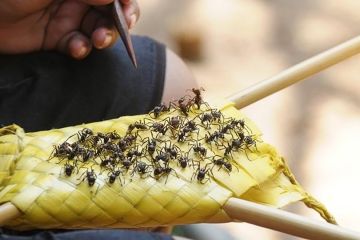
The highlight and thus most memorable event of your stay with the Sateré-Mawé will be the preparation and participation in the Dança da Tucandeira known as the traditional initiation rite of the tribe. You will see how the anaesthetics for the ants are prepared and will hike with a group of natives into the jungle to catch the ants, and see how the youngsters paint their arms and body for the ceremony. Finally you will witness the extraordinary ceremony when hundreds of bullet ants (Paraponera clavata) sting through the fibre glove into the hand of the dancer joining in the round dance.
Since the region is also a big producer of Bertholletia excelsa, the Brazil nut, another ride with the flying motor boat followed by a jungle hike will take us to the Brazil nuts trees. Here you will witness the harvests of this wonderful fruit from which it is said that is retards the ageing of brain cells.
The florae and faunae of the Amazonian environment is another interesting aspect of your discoveries around the village ; medical herbs and plants, many of them the basis for most of our synthetically produced medicines, can be identified here. Observation of wild life is more difficult due to the fact that the tribes hunting activities of the past has contributed to the reduction of available game.

You may want to have a glimpse into the classroom where the Sateré-Mawé children study in língua geral and Portuguese. Emphasis is given to studying issues related to nature and the environment, as both are the basis for survival of not only the Sateré-Mawé people but their culture and the space they have inhabited for generations.
The tour can be combined with one of our other Amazon programs such as the Jaú Nationalpark. Additionally, the stay in Manaus can be extended.
continue to the prices & travel dates
prices & dates
Prices & Travel Dates
Secrets of the Amazon: The Satéré-Mawê in the Rio Marau Region
| Prices | ||
|---|---|---|
| 2 participants | 5,200 US$ | per person |
| 3 participants | 4,250 US$ | per person |
| 4 participants | 3,850 US$ | per person |
| Travel Time | ||
| 9 days / 8 nights | ||
| Travel Dates | ||
| Travel dates on request | ||
Our price includes:
- Transfer from and to the airport in Manaus
- Hotel and Breakfast in Manaus
- City Tour in Manaus
- Private flight to Maués and boat transfer to the village
- Accommodation (in hammocks) and meals during the stay with the Sateré-Mawé
- All activities mentioned in the itinerary
- Bilingual guide
Our price does not include:
- Flight to Manaus
- Lunch and Dinner in Manaus
- Alcoholic Beverages
- Tips
Payment conditions
Upon confirmation a deposit of 30% to our German bank account becomes due. The remaining amount must be deposited on our account 30 days before the beginning of the expedition. The deadline for reservations is 40 days before your trip.
Best time to travel
The tour takes place throughout the year. Recommended time for travelling is June - November.
Difficulty level
Easy jungle hikes. Average physical fitness required.
Climate
Equatorial, average 80 % humidity, hot average + 25° C, precipitation 3,496 mm/year!
What to pack
Clothing should include two set of shorts, shirts with long sleeve, light cotton socks, swim wear, several sets of t-shirts and underwear, a rain cape, warm clothing for the night. Solid rubber trekking sandals to ford or bathe in creeks.
Equipment: travel back-pack and small attached back-pack for day hikes, sleeping bag, thermo flask, binoculars, photo equipment, flash light, swiss army knife or similar,hut, sunglasses, insect repellent.
Health
Vaccines mandatory: yellow fever, hepatites, tetanus.
Vaccines not mandatory: malaria prophylaxis.
Drinking water
Mineral water available
First aid
Granted by guides, but bring your personal/prescription medication.
Meals
Fresh meat and fish, soups, rice, beans, pasta, fresh vegetables, crackers, cookies, biscuits, banana and guava sweets, coffee, tea, milk.
Disclaimer of warranty
This journey has the character of a light expedition. Rivers and rainforest replace highways, streets and roads. The conditions which are encountered on route will be completely new for the traveler. A correct attitude and mental preparedness for a different and fascinating environment is imperative. The unexpected can happen, whereupon the traveler is expected to react, depending on the situation, in a relaxed or quick manner. The guides, with their knowledge of the environment, are experienced trekkers and expedition leaders and absolutely reliable. The willingness of the traveler to cooperate and interact tolerantly with other participants is required in all situations, even when strenuous. As operator we disclaim ourselves of any warranty for any risk during this journey.
back to the itinerary & activities

